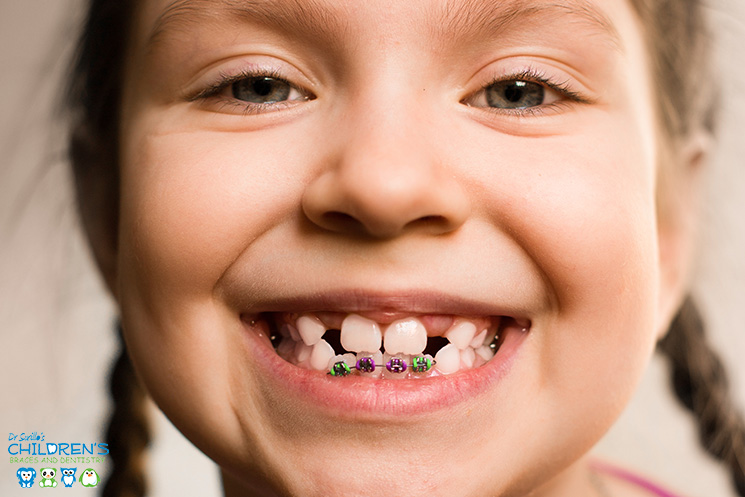Should Braces Go On Before the Baby Teeth Fall Out?

Pediatric dentistry is a branch of general dentistry in which the specialist dedicates attention to the dental treatment of children. One of the most significant advantages of pediatric dentistry is that the specialist can identify orthodontic issues that require early special care.
The pediatric dentist develops his work in healthy patients where the treatment can be less invasive. In addition, in pediatric dentistry, the specialist can observe the continuous development of their little patients.
This is why we recommend the first pediatric dentistry visit at six months of the infant’s life, continuous monitoring when their teeth and molars erupt, and periodical visits to observe the development of the infant’s daily life, including their eating and oral hygiene habits during childhood.
This article discusses the importance of perfect-time pediatric dentistry evaluations, the first orthodontic consultation at age six, and follow-up orthodontic check-ups during childhood.
Can Your Kid Start Orthodontic Treatment if Still Have Baby Teeth?
Yes, your child can start orthodontic treatment when she still has some baby teeth. Dr. Surillo can see if there is enough space for the eruption of teeth and molars.
After an initial evaluation, the pediatric orthodontist can start a phase 1 treatment that often involves applying palatal expanders or guided tooth extraction to define the space where the permanent teeth will erupt with the help of x-rays to review what’s happening under the hood.
However, a little patient can use braces only on permanent teeth since their use on baby teeth could alter the correct development of permanent teeth. For this reason, it is advisable to start with braces once our little patient has at least some permanent strategic teeth.
For these reasons, a pediatric dentist must monitor your child so that later, the pediatric orthodontist initiates a phase 1 orthodontic treatment that involves anticipating the eruption of permanent teeth and molars in the correct position.

How Many Teeth Do You Have To Lose to Get Braces?
There is no definite answer to this question. Quoting Dr. Surillo: “There might be patients with overcrowding with little to no space for permanent teeth to erupt in their adequate position. We might recommend braces, even if there is still some baby tooth. Furthermore, braces might serve to help baby teeth to loosen and fall. This frees space for the newly coming teeth to come safe and sound.
What Is Phase 1 Orthodontics?
As previously anticipated, the first dental appointment should be followed up with regular visits when the first baby teeth erupt.
Around the ages of 6 and 7, Dr. Surillo will observe the dental replacement, the bone growth, and the adequate relationship between them. When he observes an anomaly, he might recommend starting with phase one orthodontics, also known as an interceptive treatment.
For example, in the evaluation, Dr. Surillo observes if an asymmetrical mandibular growth occurs when the mandible grows forward or backward to the maxilla, preventing correct chewing (misaligned bites) and how this might affect facial symmetry.
Dr. Surillo might also observe anomalies such as a narrow arch, which can limit the space for the eruption of the permanent molars (adult teeth) and cause more significant asymmetries later. Consequently, Dr. Surillo might adopt an approach recommending the use of orthodontic appliances.
In many cases, our little patient might require a palatal expander for several months to widen the palate and improve the transverse bite. In most cases, the expander might be sufficient within the first phase for growth guidance.
However, it is necessary to bring the jaw forward or retract it in complex cases. In such circumstances, your kid may require to use headgear.
Suppose our little patient has at least some key permanent teeth. After a thorough evaluation, Dr. Surillo might determine he needs to level some teeth, for example, the upper incisors; he might recommend metal braces orthodontics within the first phase.
When the child completes her dental replacement and all permanent adult teeth erupt, she may be a candidate for second-phase orthodontics to get all her teeth aligned. This phase will be much simpler and shorter than it would be if we had not carried out the first phase of dentofacial orthopedics. In short, it will make it easier to help your kid get a beautiful smile.

Can Braces Make Teeth Fall Out?
No, orthodontic treatments are completely safe and do not cause teeth to fall out. Orthodontists are highly trained specialists and perform examinations to know the dental health status of their young patients before braces, during, and after orthodontic treatment.
This ensures that tooth decay, cavities, or periodontal disease (gum disease) do not develop and weaken the roots of the teeth. If so, the pediatric orthodontist will stop treatment in those cases until the patient’s oral health is optimal again.
In addition, orthodontists master biomechanics and the correct application of forces so as not to damage your child’s periodontal ligament. All these measures and many more guarantee that orthodontic treatment is successful and that no tooth falls out due to the process.
How Many Teeth Do You Need To Get Braces?
There is no specific number of permanent teeth to start orthodontic treatment with braces. However, it is essential to know that these treatments require an anchor tooth to be able to move other teeth.
In short, the pediatric orthodontist will evaluate if there are molars that can work as anchors and consider other elements, such as lack of space, and teeth with braces before and after.
Call Dr. Surillo or Make An Appointment at Children’s Braces and Dentistry
There is no better way to help your kid have optimal development of her oral health than taking early action. Dr. Surillo and his team will guide your kid’s oral development to minimize or eliminate the possibility of a traumatic orthodontic treatment later in her teen years.
Make an appointment and help your kids start the journey to healthy, lasting smiles.

